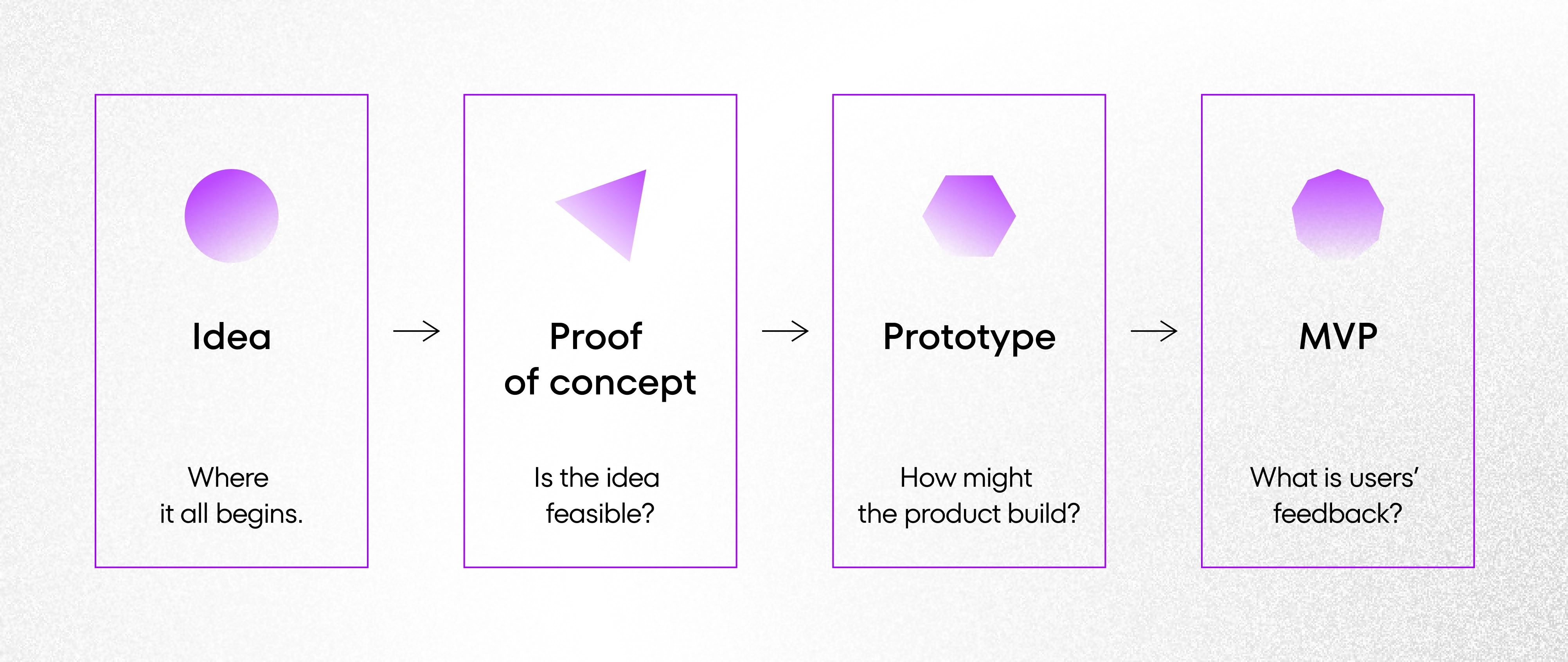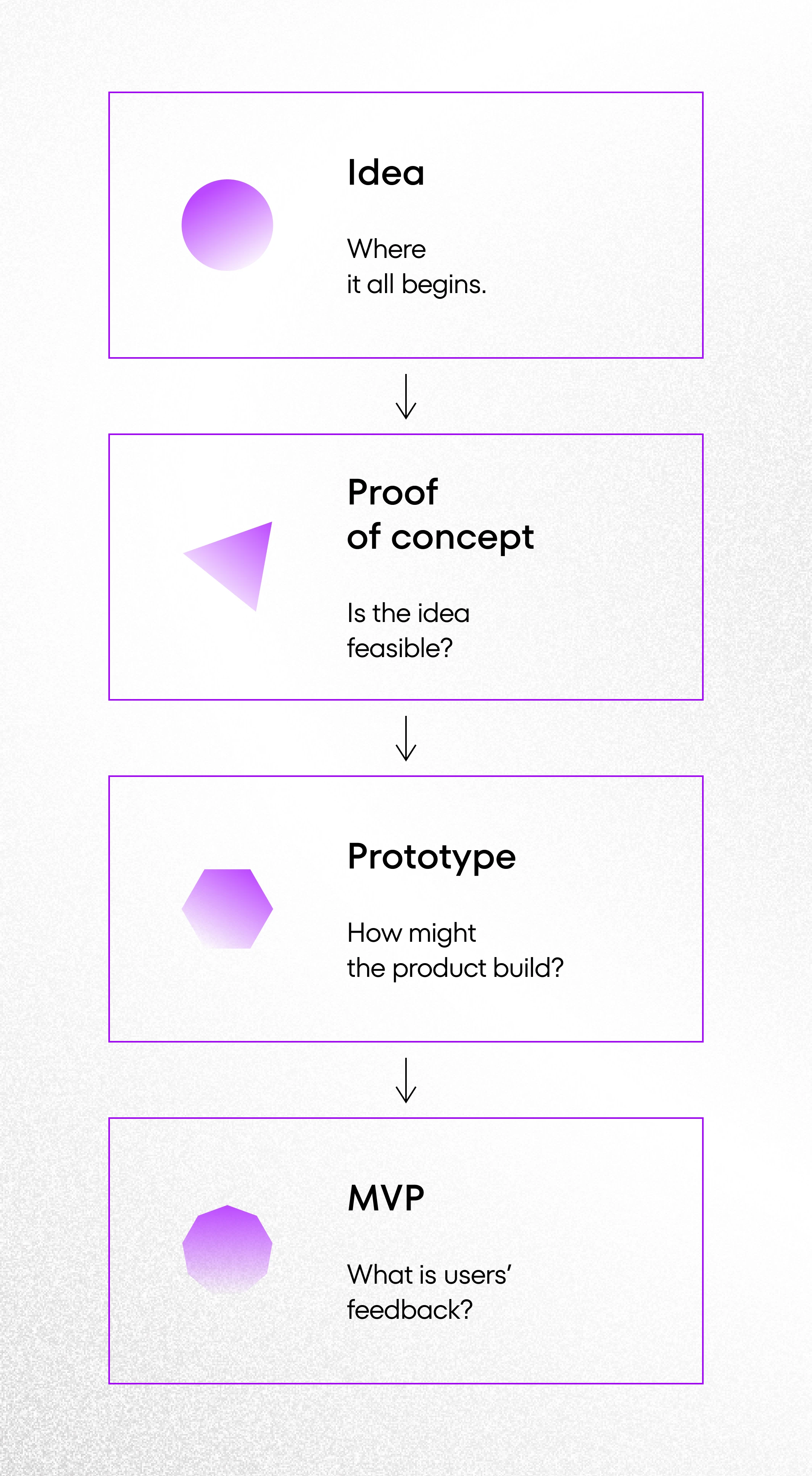September 8th, 2022 | by CSHARK
What is a Proof of Concept (POC) - Definition and meaning

Table of contents
Every day, thousands of ideas are born.
Some of them turn into big successes, but others don’t even have a chance to begin with. Why so?
Because the idea-givers didn’t think about the aspects such as: will the product be helpful, profitable, feasible, and do people actually need it in their lives?
Today, we’ll talk about proof of concept – the best way to discover the potential of your business idea.
What is a proof of concept?
A proof of concept (PoC) is a validation of an idea, so we can treat it as the first step in software development.
It falls right after the product’s general concept is set as a feasibility test that determines whether an idea can be executed or not. PoC can also be viewed as research that aims to validate an idea, approach, solution, or process.
Examples of PoC in different industries
Businesses in almost any field need a proof of concept to validate their plans as it acts as insurance that the product will work. Let’s take a look at some of them.
Proof of concept in healthcare
In healthcare, each new drug goes first through a PoC study in order to validate its effects. In this case, a proof of concept includes tests on a small group of patients.
Proof of concept in film
Many directors produce movies as proof of concept to show the movie studios and producers. A great example of that may be a short film created by Robert Rodriguez to show the technique he wanted to use in Sin City.
Proof of concept in cybersecurity
PoC, also known as proof of concept exploit, in cybersecurity is quite the opposite of how it is viewed in other industries. Here, it has to prove that a system doesn’t work. It’s performed by white hat hackers to prove that software or hardware isn’t secure enough.
Proof of concept in software development
In software development, we can distinguish 3 types of PoC.
- Steal thread – a fancier version of proof of concept which takes into account the design, software architecture, and profitability of the product.
- Proof of technology – testing the technical issues that may influence the development. A PoT tests different features of the software and their compatibility.
- Pilot project – similar to MVP, it’s an early version of the software that is tested by a small group of users. We can look at it as a kind of beta version for gathering feedback and fixing any issues.
What is the difference between a prototype, PoC, and an MVP?
When researching proof of concept, you will most probably come across notions like prototype and MVP. To be on the same page, let’s quickly share the similarities and differences between them.
While the proof of concept is an idea validation, a prototype helps to visualize the actual product. This means a prototype goes a step further with its main goal being to present how the product can be built. In the case of software development, an example of a prototype is a clickable mockup. It gives a better understanding of the product, its functionalities, as well as requirements.
On the other hand, an MVP (Minimum Viable Product) is the first version of the product, ready to be launched, but often lacking some of the fancier functionalities. An MVP build should be quick, with only the most crucial features that can be validated by the end-users. An MVP should be just enough to convince investors or any skeptical users.
That being said, we can view a proof of concept, prototype, and MVP as connected steps where one follows the other on the natural path of product development.
TLDR: a proof of concept helps to decide whether the idea is feasible. If yes, there comes the prototype, which gives it a more tangible form. And at the very end, we have the MVP, which is the closest to the final product and helps to validate the product against the target audience.


Why do you need a PoC?
The main goal of a proof of concept is to validate whether an idea has the potential to become something bigger.
There’s obviously the possibility that your idea isn’t the best, but early identification of the underlying problems will save your resources, and allow you to dive into another product.
Advantages of PoC:
- Time and cost savings – instead of investing in a flawed idea, you gain a certainty that your product can take the world by storm. A proof of concept helps to determine the costs, and necessary resources for the idea to come to life, and it can serve as an initial roadmap with set goals, targets, and expenses.
- Feedback about the market state – a proof of concept will give you crucial information about the market demand, target audience, and possible pain points. It can also help you determine how likely the customers are to adopt your product.
- Help in negotiations – a PoC can give the investors the final push and a go-ahead for your product during negotiations. It helps to build confidence in your ideas.
- Showing if the workflow plan needs alterations while also revealing potential roadblocks.
What is the most common mistake when writing a Proof of Concept?
One of the most commonly faced problems is the failure of backing up your idea with adequate data. A well-prepared proof of concept should be persuasive, but with realistic goals and account for possible obstacles. It’s also important to say how will you measure the success of your plan in order to keep it on track at all times.
How to create the best Proof of Concept?
In order to create a good proof of concept, it’s important not to skip a few crucial steps.
1. Determine your target group
How do you want to build a product without knowing your target audience? While discussing that with your team, you should try to answer questions like:
- Which market do you want your product to appear in?
- What does the end user of your product look like?
- What benefits will your solution bring to the table?
- Research your competition
It’s nice to know who you’re up against (if anybody at all). Maybe there already is a similar product on the market. If so, try to carefully analyze it, find the possible weak spots, and read reviews of the users. After all, you want your product to be better than your competitors’.
2. What will I need to succeed?
Now it’s time to determine what technology will be the most suitable for your solution, and which resources you need. You may discover you need more people on board and will have to find a development partner. Always remember that a poorly chosen team can have a big impact on the success of your product.
Here you can also try to define the so-called success criteria and estimate the duration and effort needed to finish the pilot project. Set long-term goals and think about what you want to achieve.
3. Get feedback and act accordingly
It’s important to develop apps with users in mind and examine the final product from their point of view, together with a detailed user journey from the moment they open the app until they reach the destination (eg. finalize the transaction).
A good idea is to also validate your PoC among colleagues not directly involved in the process. Listen and learn. Gather their feedback, and never give up. Adjust if needed or start over.
When to use a Proof of Concept?
Now, you may wonder if you need to have a proof of concept after all.
In software development, apart from when you’re building a product, we can generally say that writing a PoC is useful when:
- you’re upgrading your existing product – so you won’t have to put the company at risk,
- you’re planning a 3rd party integration – so you first test its feasibility,
- you’re choosing a new technology – so you determine which is the best without building a product.
Summary
For some people, a proof of concept is viewed as an unnecessary waste of time and money.
Don’t listen to them – in fact, the lack of it is a great way to lose even more since all ideas need to be reviewed. Product development can’t move further without evidence that a viable product can be created at the end of the road.
Although a well-written proof of concept requires careful planning and research it’s worth the hustle. Just ask Pixar or Airbnb.


